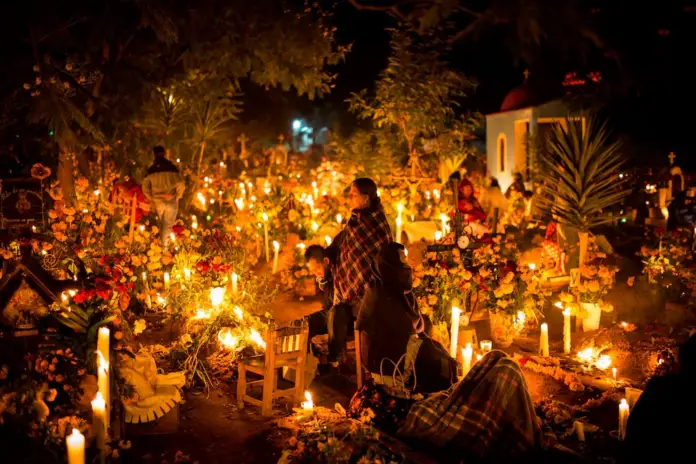
The Night of Souls and the Day of the Dead are celebrations that fill Michoacán with color in the first days of November, and although visitors may think that both are the same, in reality they have distinctive nuances and activities despite being related to the traditions of the faithful departed.
The Night of Souls is a Purépecha tradition that takes place on the night of November 1 to 2 in the communities of Pátzcuaro, when the cemeteries next to the lake are illuminated with candles, while the inhabitants hold vigils next to the graves of their loved ones.
It is a night of contemplation and family reunions, in which the return of the souls of the deceased is awaited.
Contrary to what many believe, the Purépechas do not celebrate death, but life after death, and they take advantage of this holiday to meet once a year with those who have passed away. Families gather to share food with their loved ones who return from the afterlife.
The Day of the Dead, on November 2, is the culmination of this festivity and resembles the traditions of the rest of the country, as altars are placed with offerings in honor of the deceased, including food, drinks, cempasúchil flowers and objects that are meaningful to them.
On this date, the memory of loved ones is celebrated, with a mix of solemnity and festivity, preserving indigenous traditions and the cultural identity of the region.
They invite you to enjoy the traditions of Michoacán
Pátzcuaro, in the state of Michoacán, is preparing to receive thousands of visitors during the festivities of the “Night of Souls” and the “Day of the Dead,” which will be celebrated from October 29 to November 2.
Deputy Vanessa López Carrillo of the Labor Party (PT) extended an invitation to national and international tourists to participate in these celebrations, which are a pillar of the Purépecha tradition and a source of pride for the region.
Accompanied by the mayors of Pátzcuaro, Tzintzuntzan, Taretan and Tacámbaro, López Carrillo highlighted the cultural and economic importance of these festivities. An economic impact of more than 350 million pesos is expected in the municipalities of the Lake District, which include Santa Clara del Cobre, Tzintzuntzan, Erongarícuaro, Quiroga and Pátzcuaro.
During the press conference, the mayor of Pátzcuaro, Julio Arreola, explained that the festivities begin on October 31 with the arrival of the spirits of children and continue on November 1 with that of adults. The graves are decorated with cempasúchil flowers and altars are erected in the houses that represent the underworld, the present world and the upper world.
For his part, the municipal president of Tacámbaro, Salvador Bastida, mentioned that in his town the largest altar to the dead in Michoacán is built annually, along with a replica of the Edicule of the Holy Sepulchre. Meanwhile, the municipal president of Taretan, Francisco Venera, invited people to experience it in person, highlighting the local production of sugar cane and guava.
These festivities are not only a tribute to the deceased, but also an opportunity to enjoy cultural, tourist and recreational activities that reflect the richness of Michoacán culture. The deputy concluded that those who experience the “Night of Souls” and the “Day of the Dead” in Michoacán are captivated by the experience and feel the desire to return.
Source: infobae






